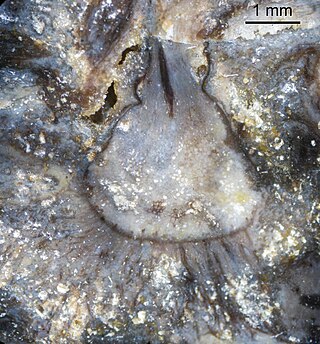
Flowering plants are plants that bear flowers and fruits, and form the clade Angiospermae, commonly called angiosperms. They include all forbs, grasses and grass-like plants, a vast majority of broad-leaved trees, shrubs and vines, and most aquatic plants. The term "angiosperm" is derived from the Greek words ἀγγεῖον / angeion and σπέρμα / sperma ('seed'), meaning that the seeds are enclosed within a fruit. They are by far the most diverse group of land plants with 64 orders, 416 families, approximately 13,000 known genera and 300,000 known species. Angiosperms were formerly called Magnoliophyta.

The Nymphaeales are an order of flowering plants, consisting of three families of aquatic plants, the Hydatellaceae, the Cabombaceae, and the Nymphaeaceae. It is one of the three orders of basal angiosperms, an early-diverging grade of flowering plants. At least 10 morphological characters unite the Nymphaeales. One of the traits is the absence of a vascular cambium, which is required to produce both xylem (wood) and phloem, which therefore are missing. Molecular synapomorphies are also known.

Monocotyledons, commonly referred to as monocots, are grass and grass-like flowering plants (angiosperms), the seeds of which typically contain only one embryonic leaf, or cotyledon. They constitute one of the major groups into which the flowering plants have traditionally been divided; the rest of the flowering plants have two cotyledons and are classified as dicotyledons, or dicots.

The Cornaceae are a cosmopolitan family of flowering plants in the order Cornales. The family contains approximately 85 species in two genera, Alangium and Cornus. They are mostly trees and shrubs, which may be deciduous or evergreen, although a few species are perennial herbs. Members of the family usually have opposite or alternate simple leaves, four- or five-parted flowers clustered in inflorescences or pseudanthia, and drupaceous fruits. The family is primarily distributed in northern temperate regions and tropical Asia. In northern temperate areas, Cornaceae are well known from the dogwoods Cornus.

The Elaeagnaceae are a plant family, the oleaster family, of the order Rosales comprising small trees and shrubs, native to temperate regions of the Northern Hemisphere, south into tropical Asia and Australia. The family has about 60 species in three genera.

Gnetophyta is a division of plants, grouped within the gymnosperms, that consists of some 70 species across the three relict genera: Gnetum, Welwitschia, and Ephedra. The earliest unambiguous records of the group date to the Jurassic, and they achieved their highest diversity during the Early Cretaceous. The primary difference between gnetophytes and other gymnosperms is the presence of vessel elements, a system of small tubes (xylem) that transport water within the plant, similar to those found in flowering plants. Because of this, gnetophytes were once thought to be the closest gymnosperm relatives to flowering plants, but more recent molecular studies have brought this hypothesis into question, with many recent phylogenies finding them to be nested within the conifers.

The Aristolochiaceae are a family, the birthwort family, of flowering plants with seven genera and about 400 known species belonging to the order Piperales. The type genus is Aristolochia L.

Ranunculaceae is a family of over 2,000 known species of flowering plants in 43 genera, distributed worldwide.

Bennettitales is an extinct order of seed plants that first appeared in the Permian period and became extinct in most areas toward the end of the Cretaceous. Bennettitales were amongst the most common seed plants of the Mesozoic, and had morphologies including shrub and cycad-like forms. The foliage of bennettitaleans is superficially nearly indistinguishable from that of cycads, but they are distinguished from cycads by their more complex flower-like reproductive organs, at least some of which were likely pollinated by insects.

Coriaria is the sole genus in the family Coriariaceae, which was described by Linnaeus in 1753. It includes 14 species of small trees, shrubs and subshrubs, with a widespread but disjunct distribution across warm temperate regions of the world, occurring as far apart as the Mediterranean region, southern and eastern Asia, New Zealand, the Pacific Ocean islands, and Central and South America.

Chloranthaceae is a family of flowering plants (angiosperms), the only family in the order Chloranthales. It is not closely related to any other family of flowering plants, and is among the early-diverging lineages in the angiosperms. They are woody or weakly woody plants occurring in Southeast Asia, the Pacific, Madagascar, Central and South America, and the West Indies. The family consists of four extant genera, totalling about 77 known species according to Christenhusz and Byng in 2016. Some species are used in traditional medicine. The type genus is Chloranthus. The fossil record of the family, mostly represented by pollen such as Clavatipollenites, extends back to the dawn of the history of flowering plants in the Early Cretaceous, and has been found on all continents.

The Cabombaceae are a family of aquatic, herbaceous flowering plants. A common name for its species is water shield. The family is recognised as distinct in the Angiosperm Phylogeny Group IV system (2016). The family consists of two genera of aquatic plants, Brasenia and Cabomba, totalling six species.

Horneophyton is an extinct early plant which may form a "missing link" between the hornworts and the Rhyniopsida. It is a member of the class Horneophytopsida. Horneophyton is among the most abundant fossil organisms found in the Rhynie chert, a Devonian Lagerstätte in Aberdeenshire, UK. A single species, Horneophyton lignieri, is known. Its probable female gametophyte is the form taxon Langiophyton mackiei.

Mesangiospermae is a clade of flowering plants (angiosperms), informally called "mesangiosperms". They are one of two main groups of angiosperms. It is a name created under the rules of the PhyloCode system of phylogenetic nomenclature. There are about 350,000 species of mesangiosperms. The mesangiosperms contain about 99.95% of the flowering plants, assuming that there are about 175 species not in this group and about 350,000 that are. While such a clade with a similar circumscription exists in the APG III system, it was not given a name.
Drewria potomacensis is a Cretaceous megafossil member of the Gnetales, from the Potomac Group, hence its name. It was possibly a shrub. It is the only known species in the genus Drewria.
Else Marie Friis is a Danish botanist and paleontologist. She is Professor Emerita in the Department of Geoscience at Aarhus University. Her work has been fundamental in the phylogenetic analysis of angiosperms, with widespread application to reproductive biology.

Erdtmanithecales is an extinct order of gymnosperm plants known from the Mesozoic era. Known remains include pollen organs and seeds associated with Eucommiidites pollen, which is considered diagnostic for the order. The order was first described in 1996. While Eucommiidites pollen first appears in the Early Jurassic, associated floral remains are not found until the Early Cretaceous. It is thought that the group are closely related to Gnetales as well as possibly Bennettitales.
Teixeiraea is an extinct genus of eudicot plants which was found in Vale de Agua 320, Portugal during the Cretaceous period. It was first named by M. von Balthazar, K. Raunsgaard Pedersen and E. M. Friis in 2005 and the type species is Teixeiraea lusitanica.
Paisia is an extinct genus of eudicot plants from the Cretaceous period. Found in the Almargem Formation, Early Cretaceous near Catefica, Portugal, it was first named by Else Marie Friis, Mário Miguel Mendes and Kaj Raunsgaard Pedersen in 2018. The type species is Paisia pantoporata.

Pluricarpellatia peltata was a species of herbaceous aquatic plant, which occurred in the early Cretaceous period of Brazil.















